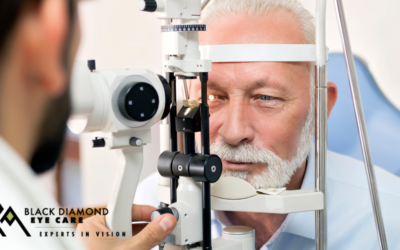Plus Risk Factors, Signs, and Treatment for these 5 Eye Diseases
Having regular eye exams isn’t just about correcting refractive issues with glasses or contact lenses. It is also about tracking your eye health and looking for diseases that could lead to vision impairment or even blindness if not taken care of early. So skipping an exam could mean lower outcomes for your eye health!
The more you know about eye diseases and conditions, the more proactive you can be when it comes to your own eye health. Here are five eye conditions you need to know about.
1 | Dry Eye
Over half of adults suffer with dry eyes, a condition that causes the eyes to be chronically dry. This is very common with our low humidity environment in Colorado. Dry eye occurs when the eyes don’t produce enough components of tears, most commonly the mucous and lipid portion of the tears.. While dry eye might seem like a minor inconvenience, it can actually have a significant impact on your life. It can lead to symptoms including dryness, itching, redness, eye pain, and even permanent vision loss.
What leads to dry eye: prolonged use of electronic devices and computer screens, environmental factors (dry/fast flowing air, pollution, indoor heating), certain medications (like allergy meds), hormonal changes, aging
Conditions that can reduce tear output: diabetes, rheumatoid arthritis, sjogren’s syndrome, lupus, scleroderma, thyroid disease, graft vs. host disease, sarcoidosis, corneal nerve desensitization, vitamin A deficiency
Treating dry eye: your eye doctor may prescribe medications, special contact lenses, or artificial tears or oil-based eye drops. In some cases, a procedure called punctal occlusion may be recommended. Additionally, we have new FDA approved treatments including IPL (Intense Pulse Light) and ILUX to help treat the causes of dry eye, not just the symptoms.
2 | Glaucoma
Glaucoma is the number one cause of irreversible blindness worldwide. The most common form occurs when there is high pressure inside the eye, caused by a build-up of fluid that cannot drain properly. Glaucoma unfolds gradually and painlessly, without apparent symptoms until vision loss reveals severe damage, making regular exams even more important.
Contact a doctor or an emergency room if you experience: intense eye pain, nausea, red eye, blurry vision
Risk factors for glaucoma: people over the age of 60 (especially if you are Hispanic/Latino), are African American over the age of 40, have a family history of glaucoma
Learn more about glaucoma in one of our recent articles!
3 | Cataracts
Cataracts are the most common cause of vision loss in adults over the age of 45 and is a clouding of the eye’s focusing lens, resulting in blurry vision. It can eventually lead to vision loss if left untreated. As we age, the proteins in the lens begin to lose their transparency and collect, leading to the cloudiness.
Risk factors for cataracts: smoking, excessive alcohol consumption, prolonged exposure to UV radiation, obesity, diabetes, hypertension, prolonged use of steroids or statin medications, eye injury or eye surgery, nutritional deficiency
Common signs and symptoms of cataracts: blurry or cloudy vision, glare sensitivity from sunlight or headlights, seeing halos around lights, poor night vision, colors appearing less vibrant, double vision
Treatment: wearing anti-glare sunglasses, glasses with magnification lenses, or stronger optical prescription. If your cataracts become severe, surgery will be recommended.
4 | Diabetic Retinopathy
Diabetic retinopathy is a serious sight-threatening complication of diabetes. It occurs due to high levels of sugar in the bloodstream that result in progressive damage to the light detecting retina. This condition affects 1 in 3 people with diabetes and 1 in 2 people are unaware they have it. Unfortunately, chronic and uncontrolled diabetes can lead to blindness.
Symptoms of diabetic retinopathy: blurry/cloudy vision, double vision, seeing floaters, increasing dark spots, near vision difficulty, poor night vision
Risk factors for diabetic retinopathy: type 1 or type 2 diabetes, gestational diabetes, poorly controlled diabetes, Hispanic or African American decent, high blood pressure, high cholesterol
Treating diabetic retinopathy: treatment depends on the stage of the disease, so speak to your eye doctor about your options.
Learn more about common diabetic eye conditions, including diabetic retinopathy in this article.
5 | Macular Degeneration
Macular degeneration, also known as age-related macular degeneration (AMD), is a disease caused by deterioration of the macula, the center of the retina that controls visual acuity. This disease is the number one cause of low vision and is characterized by dark “blind” spots that appear in the center of your vision, with gradual loss of central vision and fine detail. There are two types of AMD, dry and wet, with wet being the more severe form. It is crucial for AMD to be diagnosed and treated in its early stages to prevent severe loss of vision and blindness.
Early signs of AMD: blurry vision, cloudy vision, dark “blind” spots
Signs of advanced AMD: sudden and severe vision loss, larger blind spots, loss of central vision
Treatment of AMD: There are many different treatments for AMD, which involve slowing the progression of the disease. Your eye doctor may prescribe some over-the-counter nutritional supplements. There are prescription shots, laser surgery, and photodynamic therapy that are also available.
Final Thoughts
Early detection is key for better vision and eye health outcomes! So make sure that you are getting an annual eye exam to watch for signs of any of these eye diseases that when left untreated, could lead to vision loss or even blindness.
Schedule your next eye exam today! Black Diamond Eye Care is your trusted family optometrist committed to top-notch eye care services.




